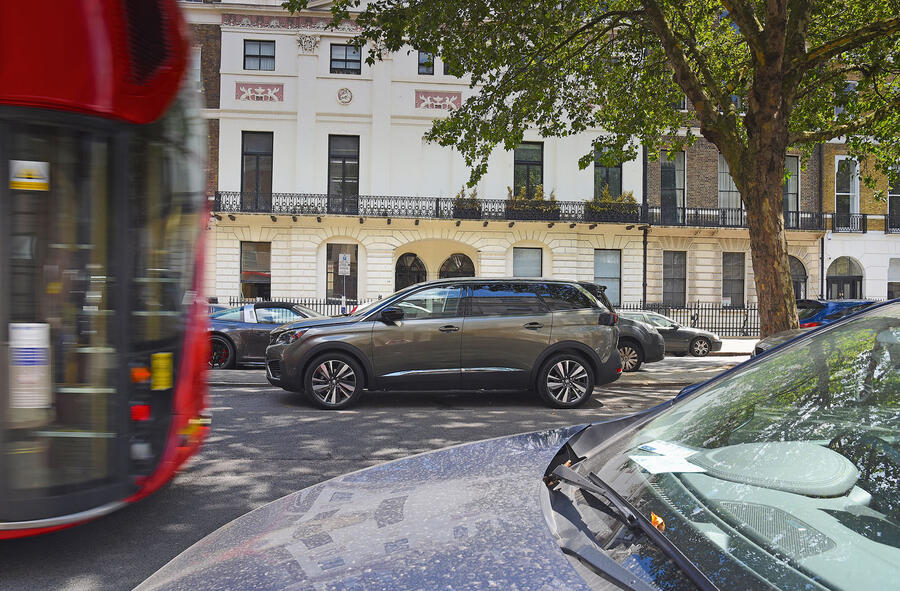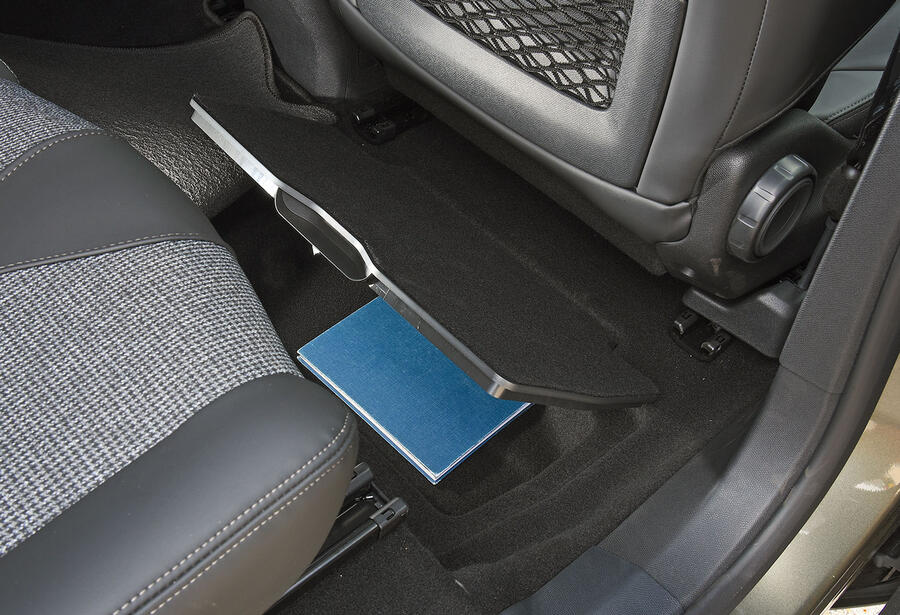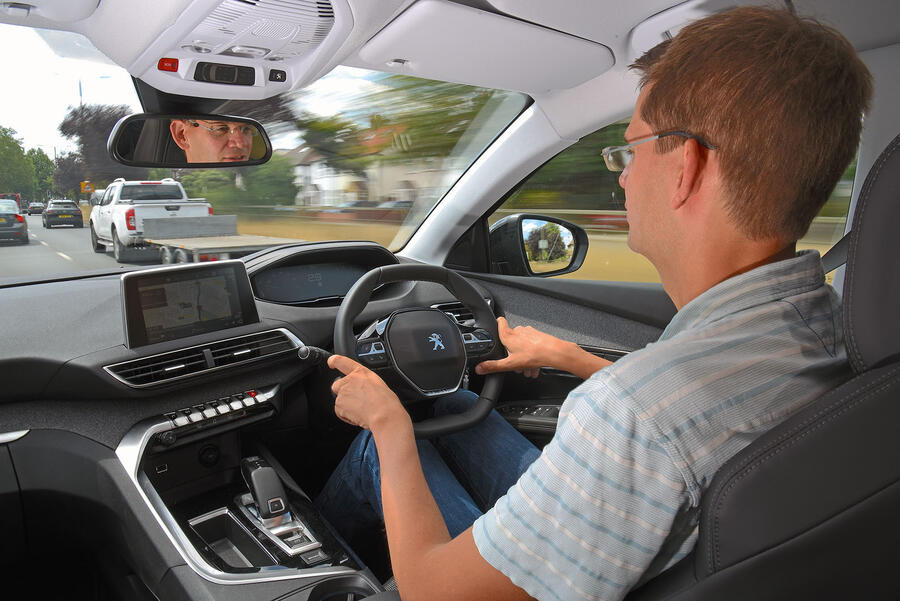Peugeot 5008 long-term review
 Our latest seven-seater has a lot to live up to, as it replaces the Skoda Kodiaq on the long-term fleet
Our latest seven-seater has a lot to live up to, as it replaces the Skoda Kodiaq on the long-term fleet
Why we’re running it: To discover if Peugeot has a class leader on its hands by fitting seven-seat MPV convenience into an on-trend SUV body
Month 3 - Month 2 - Month 1 - Specs

Life with a Peugeot 5008: Month 3
Can this accomplished SUV take the rough with the smooth? - 24th October 2018
Once upon a time, I clung on to the belief that it didn’t matter how an MPV drove, so long as it delivered men, women and children, plus the occasional dog or wardrobe, from point to point as easily as possible. Then I drove a Ford S-Max.
For while it’s true that how an MPV drives is less of a priority than for your regular hatchback buyer, it is amazing the difference being in a dynamically decent car makes. The mundane drive becomes enjoyable, challenging surfaces an aside and the very worst of our roads need raise no more than a quizzical eyebrow.
The difficulty is that you tend to get used to the positives, and set them as your minimum benchmark. What a car does well is taken for granted, and anything that aims at the same mindset but falls below that standard is a disappointment.
Now, as I move on to the Peugeot 5008, you might rush to remind me that it is definitely, absolutely not an MPV. Peugeot has gone to massive lengths to stress its metamorphosis from people carrier to sports utility vehicle. So, even though the term multiple-purpose vehicle (MPV) might well apply to either genre, Peugeot is absolutely certain that the 5008 is an on-trend SUV.
And so the pressure ramps up, because I’d argue that, in that philosophical shift, there’s an added imperative to make the car better to drive. The S of SUV stands for sports, after all, and while I’m (just about) clever enough to realise Lotus won’t be rushing to recalibrate the Evora after a spin in the 5008, that S-Max benchmark still looms large in my mind. To meet its brief, the 5008 has to be dynamically engaging.
Now, almost 4000 miles in, I’d say the 5008 delivers something that is satisfactory without ever bringing any of the sizzle that the very best drivers do, despite the best efforts of the smaller than average steering wheel delivering some directness to the experience. And – sound the klaxon – it is particularly key that you don’t upgrade your wheels to the 19in options if you want it to retain composure at all times.
On a smooth road surface it is absolutely at its best, delivering close body control and pliancy while satisfactorily insulating you and your friends from the worst effects of tyre roar and wind noise. For long motorway journeys that’s just perfect, but throw in some bigger bumps, an irregular road surface or a combination of corners and that composure is challenged.
That makes hustling the 5008 an unlikely pastime, even if it does grip surprisingly well for such a tall car. Nor does the Sport toggle add anything to the mix, offering no more than increased engine noise and perkier throttle response.
But does any of this leave me not wanting to recommend the 5008? Even in Autocar, home to the car enthusiast, no. There are better SUVs (and, hush, MPVs) to drive, but only marginally so. The shortcomings are there, but never strongly enough to unravel the compelling case built up by myriad positives for this car.
Love it:
ROBUST FURNISHINGS The elegant, characterful interior is withstanding the worst that the kids are throwing at it, from crumbs to spillages.
Loathe it:
NAVIGATING NAVIGATION The sat-nav is very good, but functions including postcode input could be more easily found.
Mileage: 3823

Don’t judge a book by its cover – or an engine by its headline figures - 3rd October 2018
Whenever I talk about the 5008, the proverbial elephant comes marching straight into the room. Eyes tighten. Eyebrows raise. Disbelief spills out.
So let’s get it out there in the open here and now, so the elephant can get back to where it belongs. Yes, the 5008 is a seven-seat SUV and, yes, it is powered by a three-cylinder 1199cc petrol engine.
I’ll accept the numbers do little to dispel the awkward glances and shuffling from toe to toe. Peaks of 131bhp and 170lb ft do not set the pulse racing. A 0-62mph time of 10.4sec might even lead you to wonder what this car is doing in Autocar.
The point being, of course, that the engine, diminutive though it may be, complements the car perfectly.
I write that with absolute confidence because, in the past month, I’ve driven the 5008 about 2500 miles. I’ve enjoyed everything from town commutes to seven-up 75-mile round trips to 250-mile runs fully laden with the family. All on a variety of motorway, A-road, B-road and whatever comes next in line down the food chain in the piddling lanes of Devon and Pembrokeshire.
Not once – not even fully laden and pulling out from a standstill with a large truck bearing down – have I wanted for performance, or had to modify my usual driving behaviour.
With shifts governed by the six-speed auto, it’s a slick, capable performer that mixes with the flow of traffic without any more compromise than a mild intrusion of noise on the rare occasions that you push it beyond about 2200rpm.
This is a truly special powertrain – and more than good enough to banish for ever the need to add the caveat “…for a three-cylinder” when talking about it. In this area at least, Peugeot (and Citroën) may well have developed a unit that is industry-leading, although the folk at Ford might quibble.

The one lingering concern I had when taking collection of the car was around fuel economy. As diesel has been demonised over the past year or so, it has become apparent that a large proportion of car buyers have gone on-trend and bought a petrol car, only to discover that what they bought doesn’t cover the number of miles to the gallon they hoped for. Which, of course, is both inevitable and why diesel makes so much sense in certain circumstances.
If I’m honest, not so long ago my default advice to any seven-seat SUV buyer planning to cover many out-of-town miles would have been to buy diesel. Now I’m not so sure – although the financial equation still hinges on just how many miles you cover (and the emotive one on which pollutant, NOx or CO2, you are most concerned about).
This 5008 is averaging 33.0mpg. I don’t have an equivalent diesel comparison (having not driven one as many miles, in the same way) but I do know that, over 12,000 miles in a diesel Skoda Kodiaq, I averaged 39.7mpg. Very roughly, that means that every mile in the 5008 is costing me around three pence more in fuel than Skoda’s diesel.
While that sounds like it could add up, a comparison of this petrol 5008 and the equivalent 1.5 HDi diesel list prices and discounts suggest a £1500 premium for the latter – a difference that I’d need to drive 50,000 miles to pay off. The difference if you choose to lease, however, is much slighter, because there appear to be some very enticing offers on the diesel out there at the moment. That suggests there are dealers keen to offload the diesels in the current climate, or that there is a greater confidence in the resale values of diesel versions of the car. Given the uncertainty, it is also possible that both could apply.
The conclusion I’d draw is that it’s a fluctuating market, and that the answer may change at any given time. But on experience so far, if you plump for this petrol-engined 5008, you won’t be disappointed.
Love it:
AUTOMATIC TRANSMISSION Some say you should save money and opt for the manual. I reckon the auto makes the driving experience seamless.
Loathe it:
EAR-PIERCING ALERTS Dare to step from the 5008 with the key still in the ignition and the ensuing audible alert is loud enough to wake the neighbours.
Mileage: 3423
Life with a Peugeot 5008: Month 2
Struggling for storage space - 19th September 2018
Is there a smaller glovebox than the 5008’s? Presumably as a result of taking the path of least resistance for the conversion to right-hand drive, there is just enough room for the ownership manuals plus, maybe, an actual pair of gloves. The unusually deep and long central storage unit compensates. It’s also air-conditioned, so the salad in your sandwiches stays crisp.
Mileage: 2987

5008 is full of secrets - 5th September 2018
I’m a big fan of underfloor storage in cars: it’s out of sight and therefore more secure, it is still accessible and oddments can be packed in so that they don’t rattle around. Full marks to the Peugeot 5008, which features several commodious hideaways and cubbies, living up to its carry-anything family brief.
Mileage: 1258

Life with the Peugeot 5008: Month 1
Welcoming the 5008 to our fleet – 15th August 2018
They say you should take your time to fall in love – but, around 30 seconds after settling into the driver’s seat of the Peugeot 5008, I was smitten.
And, before you write in, I know that sounds an odd thing to say about any car, let alone a Peugeot, but it is absolutely true. It is because this 5008’s cabin is a joy to be in and look at. Everything that you first see and touch is not only great in terms of perceived quality but interesting too.
There’s the dark faux-denim cloth that breaks up the plastic surfaces. The digital dash display. The ‘piano keys’ that operate the infotainment functions. The gearlever for the auto ’box, which looks and feels designed, rather than just plonked in. I could go on.
It’s pleasing, too, that this Allure trim is just one step up the four-strong range, which starts with Active and ends with GT Line and GT. It is described by its maker as “the ultimate in understated luxury” and, while that statement is (inevitably) laden with a touch of marketing hyperbole, I’m struggling to think of a mainstream family car that looks better inside or out.
Styling features include tinted rear windows, trim enhancements and additional chrome flourishes. All of them look good. Throw in the extra kit it adds too, including a rear-view parking camera, upgraded sat-nav and various driver assistance systems, and it makes for a highly competitive proposition.
This is a large seven-seat SUV that retails from well below £30,000 even with the cosmetic extras – and one which our sister title whatcar.com can already secure you 7-10% discounts on through its New Car Buying service, such is the competition for sales in this sector.
Even so, some context might be needed to fully explain my excited reaction. The Skoda Kodiaq from which I stepped was many great things, but its interior was as rigorously functional as the Peugeot’s is interesting. Both work in their own way, but inevitably my reaction was exaggerated by the contrast. Already, you’ll start to understand why the chance to live with these two seven-seaters back-to-back is going to be such a fascinating test.
Consequently, I’ll confront one of the prejudices that is flitting through your mind now (I know you’re thinking it because it popped into my head) – namely, that my joyous reaction to getting into the 5008 is going to be short-lived, because Peugeot means French, which means style over substance and flaky build quality. Skoda, meanwhile, means Volkswagen, which means German build quality.
Sorry, but I don’t buy it. Stereotypes are usually rooted in fact but also tend to last long beyond them being factually accurate. While the Skoda was largely trouble-free, I did have an issue with the battery that left me stranded more than once. Every Peugeot I’ve driven in the past five years – including a year spent in a 308 SW, which I found to be a very fine if not quite class-leading car – has been trouble-free.
Ownership surveys provide a more mixed view; in most, Skoda outperforms Peugeot. I am a sample size of one but, rather than leap to conclusions, let’s see how this test goes.

Nor is it just the cabin ambience that has won me over, although it is the standout surprise from my first few weeks in the car. As you might hope in a large SUV, the cabin is spacious and well laid out. The kids, so often hard to please, piped up without prompting how comfortable they are in both the rearmost and middle rows of seats. The tape measure suggests they are right.
The engine, too, is a surprise, although in the sense that it remains a critical point of interest. You don’t need to be that old to look at a seven-seat SUV powered by a 1.2-litre engine to think that it is a combination that will never work. The world has, of course, moved on, and what’s evident already in these first few hundred miles is that it works just fine: linked with the auto ’box, it’s smooth and capable enough, and the 10.4sec 0-62mph time isn’t so pedestrian as to be a nuisance.
The question marks are around what cost this has on fuel economy, occasionally refinement and the linearity of acceleration. Unladen and around town, 40mpg looks possible, but out on faster roads the concern is that it has quite a thirst. More testing will answer that particular question.
To drive, the 5008 has been decent, if not startling. The deliberately small steering wheel takes some getting used to but, thanks to my height, doesn’t obscure the dash (for normally proportioned people it could) and actually forces you to adopt an interesting, wristy steering style. In terms of engagement with the road, there’s little, but that’s the norm these days, while the ride seems mostly decent, only turning brittle and unsettled on the most broken of surfaces.
These are the chief criticisms that held it back from scoring more than a (still strong) 3.5 stars in its Autocar road test, but my suspicion is that when the destination is 200 miles away and the wife, kids and luggage are on board, it may not be my first priority. Again, we’ll see, because no Autocar reader is going to thank me for recommending a car for its ambience and practicality alone.
An intriguing six months lie ahead, then. The latest car launched by a marque should always be its best, but already I suspect this 5008 could be the firm’s very best in many years.
Second Opinion
On first acquaintance – a 200-mile motorway and B-road drive – there was lots to love about the 5008. But I couldn’t help having half an eye on the fuel meter for this low-capacity petrol car. It was dropping at a faster rate than my diesel-dominated life has come to expect.
Will Williams
Peugeot 5008 specification
Specs: Price New £28,780 Price as tested: £29,885 Options: Metallic paint (£525), ‘black diamond’ roof (£280), 19in alloy upgrade (£300)
Test Data: Engine 3cyls, 1199cc, petrol Power 128bhp at 5,500rpm Torque 170lb ft at 1750-4300rpm Kerb weight 1310kg Top speed 117mph 0-62mph 10.9sec Fuel economy 37.3mpg CO2 117g/km Faults None Expenses None

Comments
Post a Comment